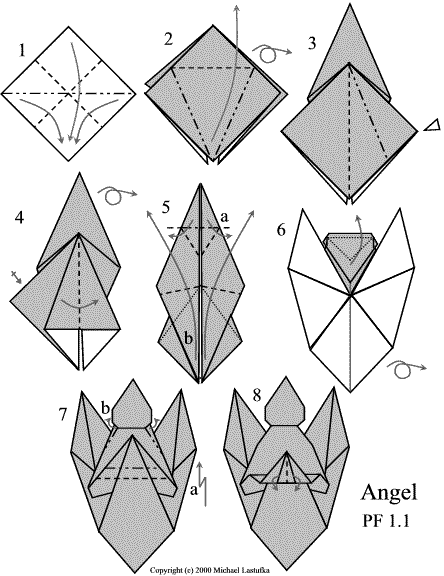Origami Angel: PF 1.1
I created this angel because we could not find the right angel pattern in a book to use in a Nativity scene. With a few modifications that turn the wings into a more lavish costume, it also became a good wiseman bearing a gift.
Folding
The folds are relatively easy, except for one or two I did not have the patience to illustrate with more drawings. The "Paper Factor" (PF) is about 1.1 - if you want the angle to be 6 inches tall, start with a 6 x 1.1 = 6.6 or 7 inch square.
Gray indicates the front side of the paper; white the back.

- Fold all corners together into a standard Preliminary Base square.
- Petal fold top layer up. Turn model over.
- Squash fold corner over the center.
- Valley fold middle flap to the side. Repeat steps 3 and 4 on the other corner. This is the front. Turn the model over.
- This is the back.
- Pull out top layers whlie folding down. Guide split layer underneath along diagonal, valley fold lines.
- Lift wings up and slightly to the side as indicated by the top-layer valley fold line. The inner diagonal valley fold lines that arise converge in the center. The edge of each wing is fully stretched.
- The most difficult fold. Mountain fold head up at front of the neck. Form diagonal valley folds at back of neck flat. These end in mountain folds that form the cheeks. Turn model over.
- The front again.
- Crimp to form arms and hands.
- Mountain fold to round off the shoulders. The upper part of this fold flips over between inner neck flaps.
- There are two nice ways to finish the hands. Use one of them, the first is easier.
- Praying: Pinch the top layers of the hands together in an attitude of prayer - the outter edges of the top layer move down together.
- Holding gift: (not shown) Squash fold point to form 3D box by pulling on diagonally oposite edges and the middle ridge that forms to each side. This works especially well in larger foil models.
To give it some personality, a few folds will make a "hair-do", a hat, horns or other ceouf. A pair of rather difficult squash folds about the neck can produce a chin. Configure the hem of the robe to suit. Some prefer ruffled wings.
Copyright © 2000 Michael Lastufka, All rights reserved worldwide.
